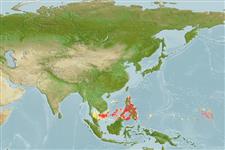Elasmobranchii (sharks and rays) >
Carcharhiniformes (Ground sharks) >
Triakidae (Houndsharks) > Galeorhininae
Etymology: Hemitriakis: hemi-, from hemisys (Gr.), half, being a genus that Herre believed was “most closely related” to Triakis (See ETYFish); leucoperiptera: leuco-, from leukos (Gr.), white; peri (Gr.), around; ptera (Gr.), fin, referring to white margin around fins (See ETYFish).
More on author: Herre.
Environment: milieu / climate zone / depth range / distribution range
Ecology
Marine; demersal; depth range ? - 48 m (Ref. 244). Tropical; 20°N - 5°N
Western Central Pacific: known only from the Philippines.
Size / Weight / Age
Maturity: Lm ? range ? - ? cm
Max length : 96.0 cm TL (female)
Dorsal spines (total): 0; Anal spines: 0. No dusky bar on underside of snout; young with dark bars on caudal fin but not elsewhere (Ref. 13563).
An little-known inshore tropical shark found in coastal waters (Ref. 13563). Ovoviviparous (Ref. 50449).
Life cycle and mating behavior
Maturity | Reproduction | Spawning | Eggs | Fecundity | Larvae
Ovoviviparous, embryos feed solely on yolk (Ref. 50449). 12 young in a litter and size at birth at least 20 to 22 cm (Ref. 244).
Compagno, L.J.V., 1984. FAO Species Catalogue. Vol. 4. Sharks of the world. An annotated and illustrated catalogue of shark species known to date. Part 2 - Carcharhiniformes. FAO Fish. Synop. 125(4/2):251-655. Rome: FAO. (Ref. 244)
IUCN Red List Status (Ref. 130435: Version 2024-2)
Human uses
Fisheries: subsistence fisheries
Tools
Special reports
Download XML
Internet sources
Estimates based on models
Preferred temperature (Ref.
123201): 28 - 28.8, mean 28.5 °C (based on 18 cells).
Phylogenetic diversity index (Ref.
82804): PD
50 = 0.5156 [Uniqueness, from 0.5 = low to 2.0 = high].
Bayesian length-weight: a=0.00427 (0.00180 - 0.01010), b=3.04 (2.84 - 3.24), in cm total length, based on LWR estimates for this (Sub)family-body shape (Ref.
93245).
Trophic level (Ref.
69278): 4.2 ±0.5 se; based on size and trophs of closest relatives
Resilience (Ref.
120179): Low, minimum population doubling time 4.5 - 14 years (Fec=12).
Fishing Vulnerability (Ref.
59153): High vulnerability (58 of 100).
